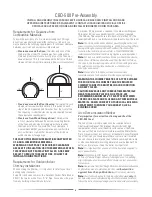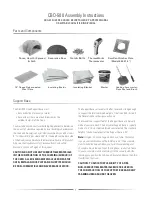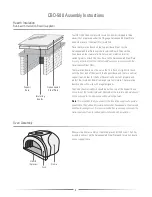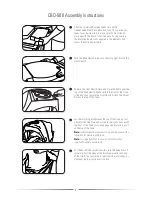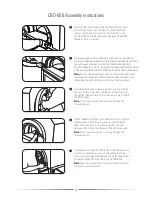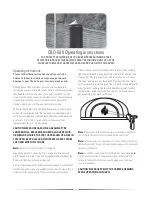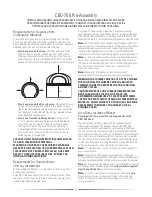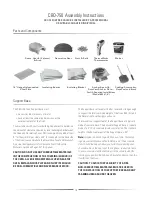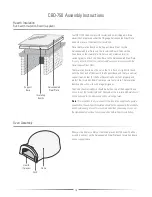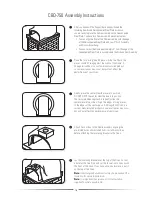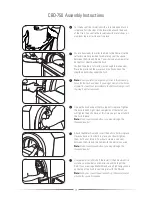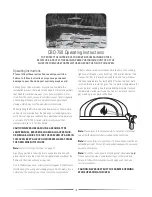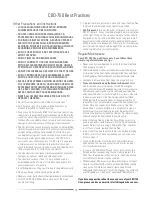
CBO-750 Best Practices
Other Precautions and Instructions
• LOCAL REGULATIONS ABOUT WOOD-BURNING
EQUIPMENT SHOULD BE CONSULTED.
• CBO-750 OVENS SHOULD BE INSTALLED BY A
PROFESSIONAL OR SUITABLY QUALIFIED INDIVIDUAL.
• FOR INDOOR INSTALLATIONS, A SOURCE OF FRESH
AIR INTO THE ROOM SHALL BE PROVIDED WHEN
REQUIRED. CHECK WITH LOCAL BUILDING OFFICIALS
REGARDING VENTILATION REQUIREMENTS.
• DO NOT USE PRODUCTS NOT SPECIFIED FOR USE
WITH THIS OVEN.
• DO NOT INSTALL IN A MOBILE HOME.
• DO NOT CONNECT TO OR USE IN CONJUNCTION
WITH ANY AIR DISTRIBUTION DUCTWORK. UNLESS
SPECIFICALLY APPROVED FOR SUCH INSTALLATIONS.
• DO NOT USE CHEMICALS OR FLUIDS TO START THE FIRE.
• DO NOT BURN GARBAGE OR FLAMMABLE FLUIDS,
SUCH AS GASOLINE, NAPHTHA OR ENGINE OIL.
• PLEASE USE EXTREME CAUTION AROUND THE OVEN.
THE OVEN DOME, HEARTH, ARCH AND DOOR WILL BE
EXTREMELY HOT WHEN IN USE AND FOR HOURS AFTER
USE. KEEP CHILDREN, CLOTHING AND FURNITURE
AWAY. CONTACT MAY CAUSE SKIN BURNS.
• NEVER ALLOW ANYONE UNDER THE AGE OF 18 TO
OPERATE THE OVEN.
• Do not throw chunks of wood violently into the Oven.
• Each time you light a fire, make sure the fire covers as
much of the Hearth surface as possible.
• Always use dry hard woods (dried for at least two years)! If you
see moisture coming from the logs while they are on the fire, the
wood is not dry.
Using wood that is not dry will cause the Oven
to throw off a considerable amount of smoke and can also cause
damage to the Oven because of the high moisture content.
• The
first two times
you cook in your new Oven, cook something
simple (for example, a pizza shell)
then throw it away
without
actually eating what you have cooked. The third time, you
can begin enjoying what you have cooked in your new Oven.
• Always pre-warm any cooking accessory (the CBO Grill, a
cast iron pot, etc.) before you put it in the Oven. If you place
a
cold
accessory on a
hot
Hearth, the thermal shock may
cause the Hearth to crack. You can also add an Oven Rack so
the pot or pan doesn’t sit directly on the Hearth.
• The manufacturer is not responsible for eventual environment
damages, nuisance or smoke and carbon particles.
• You should re-cure your Oven if it has not been used for
an extended period of time or if Oven has been exposed to
excessive amounts of moisture.
• In cold temperatures, bring your Oven up to temperature slowly.
• Never use frozen foods directly on the Hearth.
• Never use water, marinades or other liquids directly on the Hearth.
• DO NOT OVER-FIRE! When flame spills out of the Oven,
you are over-firing.
• A protective rain cap
must be installed
on top of the Flue Pipe
to ensure that moisture does not get into your Oven.
•
Ash Disposal:
Brush out the ashes after each use with your
CBO Wire Brush. Ashes should be placed in a metal container
with a tight-fitting lid. The closed container of ashes should
be placed on a non-combustible floor or on the ground, well
away from all combustible materials, pending final disposal.
When the ashes are disposed of by burial in soil or otherwise
locally dispersed, they should be kept in the closed container
until all cinders have thoroughly cooled.
Regular Maintenance
Your CBO-750 Oven will last years if you follow these
simple, regular maintenance tips:
• Never use any cleaning products inside the Oven! Heat the
Oven properly to clean it.
• The Decorative Door will occasionally show wear. Take a piece
of steel wool to the Door, lightly, and repaint the Door with black
Stove Pipe Spray Paint available at your local hardware store.
• Lubricate the Decorative Door hinges on a regular basis.
•
Creosote-Formation and the Need for Removal.
When
wood is burned slowly, it produces tar and other organic
vapors that combine with expelled moisture to form creosote.
The creosote vapors condense in a relatively cool Oven Flue
and Exhaust Hood of a slow-burning fire. As a result, creosote
residue accumulates on the Flue Lining and Exhaust Hood.
When ignited, this creosote makes an extremely hot fire. To
reduce the risk of a creosote fire, inspect the Flue Connection/
Anchor Plate on a regular basis. Make sure it is free from
any buildup. If you have buildup, use a wire brush to clean it.
Contact your local municipal or provincial fire authority for
information about how to handle a chimney fire. Have a clearly
understood plan for how to handle a chimney fire.
• Inspect the Flue Pipe on a regular basis. Make sure it is in
good repair and is seated securely into the Flue Connection/
Anchor Plate. If you are using a Single-Wall Pipe, check for
rust. If rust is found, replace the Flue Pipe.
• Inspect your Flue Cap to ensure there is no buildup blocking
the flow of air. If you have any buildup, you can use a wire
brush to clean it.
• Touch-up the mortar around the Arch to maintain a nice
finished look. You can use any refractory mortar found at
your local hardware store.
• If you use the CBO Metal Shroud in your install, cover the
Shroud with an inexpensive grill cover to help protect the
Oven from the elements when not in use. The Oven must be
cool to the touch before it can be covered.
• When using any CBO accessory, please do not allow any type of
liquid to touch the Hearth or Dome. For example: When cooking
steak on the Grill Grate, you need to create a bed of coals
underneath the Grill Grate to “catch” the drippings. You could also
use the Griddle as a “catch basin” underneath the Grill Grate.
If you have any questions about the use and care of your CBO-750
Oven, please send us an email to info@chicagobrickoven.com.
19

